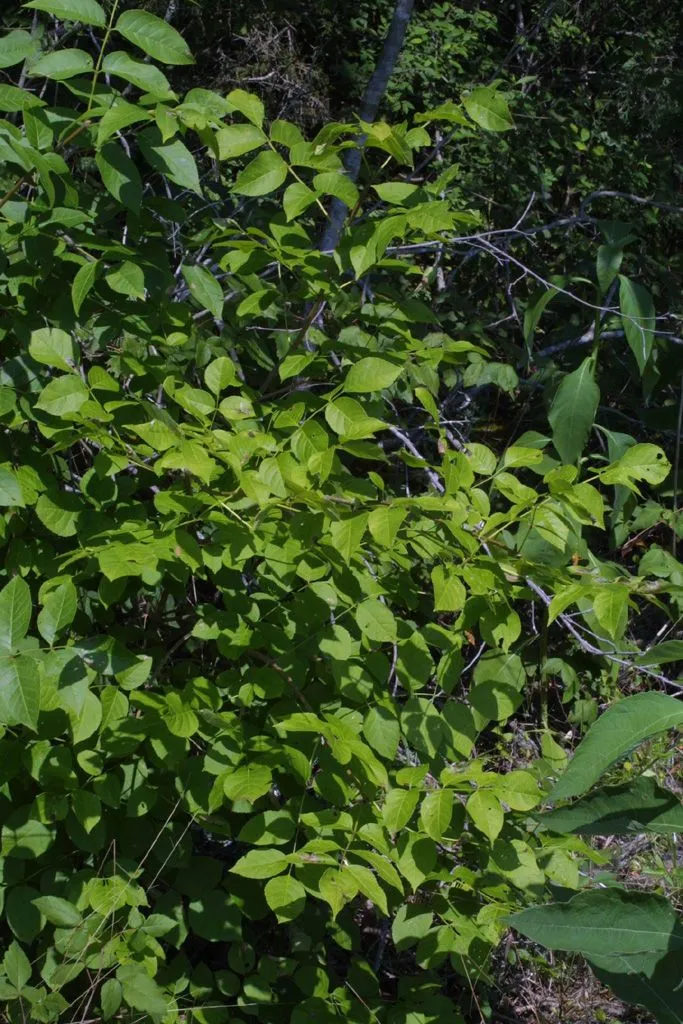
Author: Michx.
Bibliography: Fl. Bor.-Amer. 2: 255 (1803)
Year: 1803
Status: accepted
Rank: species
Genus: Fraxinus
Vegetable: False
Observations: NC. & EC. U.S.A.
Blue ash (Fraxinus quadrangulata) is a notable tree species within the family Oleaceae. It has earned its common name from the distinctive blue dye that can be extracted from its inner bark. This dye was historically significant and used by Native American tribes and early settlers.
The blue ash is native to North Central and Eastern United States, thriving predominantly in rich limestone-based soils found in open woodlands and bottomlands. This tree has a remarkable adaptability to various soil types, although it generally performs best in regions that provide ample moisture and well-drained conditions.
Fraxinus quadrangulata can be easily identified by its unique square-shaped twigs, as suggested by its Latin name “quadrangulata”. These four-angled twigs are an unusual characteristic among ashes and serve as a distinct identifying feature. The bark of the blue ash matures to a deeply furrowed gray, while its leaves, compound and pinnate, develop into a lush canopy that provides substantial shade and aesthetic appeal.
The flowers of blue ash are inconspicuous, presenting as small clusters in early spring. These flowers give way to samaras, a type of winged fruit, which are dispersed by the wind, facilitating the tree’s propagation.
Ecologically, blue ash plays a significant role in its native habitats, supporting various species of wildlife. Its robust wood is also valued in timber production for its durability and strength.
First documented in 1803 by the botanist Michaux in “Flora Boreali-Americana”, blue ash remains a researched and respected species within botanical and ecological studies. Conservation efforts are ongoing to protect this valuable species from threats such as habitat destruction and the emerald ash borer, an invasive insect that poses severe risks to ash populations across North America.
In summary, blue ash (Fraxinus quadrangulata) is a distinguished member of the Oleaceae family, known for its unique morphology, historical uses, and ecological importance. Its continued preservation is critical to maintaining the biodiversity and ecological balance within its native regions.
Deu: blau-esche
Eng: blue ash, four-angled ash
Fra: frêne bleu, frêne anguleux, frêne quadrangulaire
En: Blue ash, Four-angled ash
Ar: مران رباعي الأضلاع
Fi: Sinisaarni
Fr: Frêne bleu, Frêne anguleux, Frêne quadrangulaire
De: Blau-Esche
© copyright of the Board of Trustees of the Royal Botanic Gardens, Kew.
© copyright of the Board of Trustees of the Royal Botanic Gardens, Kew.
© copyright of the Board of Trustees of the Royal Botanic Gardens, Kew.
Taken Dec 2, 2015 by EOL − Steven J. Baskauf (cc-by-nc-sa)
Taken Dec 2, 2015 by EOL − Steven J. Baskauf (cc-by-nc-sa)
Taken Jun 18, 2002 by EOL − Steven J. Baskauf (cc-by-nc-sa)
Taken Nov 11, 2020 by Maarten Vanhove (cc-by-sa)
Taken Nov 11, 2020 by Maarten Vanhove (cc-by-sa)
Taken Aug 23, 2014 by EOL − Steven J. Baskauf (cc-by-nc-sa)
Taken Jun 18, 2002 by EOL − Steven J. Baskauf (cc-by-nc-sa)
Taken Jun 18, 2002 by EOL − Steven J. Baskauf (cc-by-nc-sa)
Taken Jun 18, 2002 by EOL − Steven J. Baskauf (cc-by-nc-sa)
Taken Oct 16, 2020 by Nicole Sattari (cc-by-sa)
Taken Jan 1, 1900 by EOL − 2010 G. Yatskievych (cc-by-nc-sa)
Taken Dec 2, 2015 by EOL − Steven J. Baskauf (cc-by-nc-sa)
Taken Dec 2, 2015 by EOL − Steven J. Baskauf (cc-by-nc-sa)
Taken Jan 1, 1900 by EOL − 2010 G. Yatskievych (cc-by-nc-sa)
Taken Jun 18, 2002 by EOL − Steven J. Baskauf (cc-by-nc-sa)
Growth habit>: Tree
Family: Myrtaceae Author: (F.Muell.) K.D.Hill & L.A.S.Johnson Bibliography: Telopea 6: 402 (1995) Year: 1995 Status:…
Family: Rubiaceae Author: Pierre ex A.Froehner Bibliography: Notizbl. Bot. Gart. Berlin-Dahlem 1: 237 (1897) Year:…
Family: Sapindaceae Author: Koidz. Bibliography: J. Coll. Sci. Imp. Univ. Tokyo 32(1): 38 (1911) Year:…
Family: Asteraceae Author: A.Gray Bibliography: Pacif. Railr. Rep.: 107 (1857) Year: 1857 Status: accepted Rank:…
Family: Fabaceae Author: Medik. Bibliography: Vorles. Churpfälz. Phys.-Ökon. Ges. 2: 398 (1787) Year: 1787 Status:…
Family: Aspleniaceae Author: (Cav.) Alston Bibliography: Bull. Misc. Inform. Kew 1932: 309 (1932) Year: 1932…